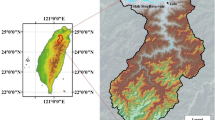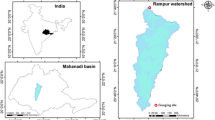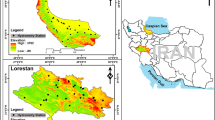Abstract
The present paper aims at modeling suspended sediment load (SSL) using heuristic data driven methodologies, e.g. Gene Expression Programming (GEP) and Support Vector Machine (SVM) in three successive hydrometric stations of Housatonic River in U.S. The simulations were carried out through local and cross-station data management scenarios to investigate the interrelations between the SSL values of upstream/downstream stations. The available scenarios were applied to predict SSL values using GEP to obtain the best models. Then, the best models were predicted by SVM approach and the obtained results were compared with those of GEP. The comparison of the results revealed that the SVM technique is more capable than the GEP for modeling the SSL through the both local and cross-station data management strategies. Besides, local application seems to be better than cross-station application for modeling SSL. Nevertheless, the cross-station application demonstrated to be a valid methodology for simulating SSL, which would be of interest for the stations with lack of observational data. Also, the prediction capability of conventional Sediment Rating Curve (SRC) method was compared with those of GEP and SVM techniques. The obtained results revealed the superiority of GEP and SVM-based models over the traditional SRC technique in the studied stations.
Similar content being viewed by others
References
Alp M, Cigizoglu HK (2007) Suspended sediment load simulation by two artificial neural network methods using hydrometeorological data. Environmental Modeling & Software 22(1): 2–13. DOI: 10.1016/j.envsoft.2005.09.009
Asselman NEM (2000) Fitting and interpretation of sediment rating curves. Journal of Hydrology 234(3): 228–248. DOI: 10.1016/S0022-1694(00)00253-5
Aytek A, Kisi Ö (2008) A genetic programming approach to suspended sediment modeling. Journal of Hydrology 351(3): 288–298. DOI: 10.1016/j.jhydrol.2007.12.005
Azamathulla HM, Ghani AA, Chang CK, et al. (2010) Machine learning approach to predict sediment load–a case study. CLEAN–Soil, Air, Water 38(10): 969–976. DOI: 10.1002/clen. 201000068
Azamathulla HM, Ghani AA, Leow CS, et al. (2011) Geneexpression programming for the development of a stagedischarge curve of the Pahang River. Water Resources Management 25(11): 2901–2916. DOI: 10.1007/s11269-011-9845-7
Basak D, Pal S, Patranabis DC (2007) Support Vector Regression. Neural Information Processing-Letters and Reveiews 11(10): 203–224.
Chiang JL, Tsai YS (2011) Suspended sediment load estimate using support vector machines in Kaoping river basin. In Consumer Electronics, Communications and Networks (CECNet), 2011 International Conference on (pp. 1750–1753). IEEE. DOI: 10.1109/CECNET.2011.5769267
Cohn TA, Caulder DL, Gilroy EJ, et al. (1992) The validity of a simple statistical model for estimating fluvial constituent loads: An empirical study involving nutrient loads entering Chesapeake Bay. Water Resources Research 28(9): 2353–2363. DOI: 10.1029/92WR01008
Crowder DW, Demissie M, Markus M (2007) The accuracy of sediment loads when log-transformation produces nonlinear sediment load–discharge relationships. Journal of Hydrology 336(3): 250–268. DOI: 10.1016/j.jhydrol.2006.12.024
Ferreira C (2001) Gene expression programming: a new adaptive algorithm for solving problems. Complex Systems 13 (2): 87–129. DOI: 10.1016/j.jhydrol.2006.12.024
Ferreira C (2006) Gene expression programming: mathematical Modeling by an artificial intelligence. Springer, Berlin, Heidelberg, New York, p. 478.
Forman SL, Pierson J, Lepper K (2000) Luminescence geochronology. Quaternary geochronology: Methods and applications: 157–176.
Gunn SR (1998) Support vector machines for classification and regression. ISIS technical report, 14.
Lafdani EK, Nia AM, Ahmadi A (2013) Daily suspended sediment load prediction using artificial neural networks and support vector machines. Journal of Hydrology 478: 50–62. DOI: 10.1016/j.jhydrol.2012.11.048
Kisi O, Cimen M (2011) A wavelet-support vector machine conjunction model for monthly stream flow forecasting. Journal of Hydrology 399(1): 132–140. DOI: 10.1016/j. jhydrol.2010.12.041
Kisi O, Shiri J (2011) Precipitation forecasting using waveletgenetic programming and wavelet-neuro-fuzzy conjunction models. Water Resources Management 25(13): 3135–3152. DOI: 10.1007/s11269-011-9849-3
Kisi O (2012) Modeling discharge-suspended sediment relationship using least square support vector machine. Journal of Hydrology 456: 110–120. DOI: 10.1016/j.jhydrol.2012.06.019
Kisi O, Dailr AH, Cimen M, et al. (2012) Suspended sediment modeling using genetic programming and soft computing techniques. Journal of Hydrology 450: 48–58. DOI: 10.1016/j.jhydrol.2012.05.031
Kisi O, Shiri J (2012) River suspended sediment estimation by climatic variables implication: comparative study among soft computing techniques. Computers & Geosciences 43: 73–82. DOI: 10.1016/j.cageo.2012.02.007
Legates DR, McCabe GJ (1999) Evaluating the use of “goodnessof-fit” measures in hydrologic and hydroclimatic model validation. Water Resources Research 35(1): 233–241. DOI: 10.1029/1998WR900018
Liu QJ, Shi ZH, Fang NF, et al. (2013) Modeling the daily suspended sediment concentration in a hyperconcentrated river on the Loess Plateau, China, using the Wavelet–ANN approach. Geomorphology 186: 181–190. DOI: 10.1016/j.geomorph.2013.01.012
Nash J, Sutcliffe JV (1970) River flow forecasting through conceptual models part I—A discussion of principles. Journal of Hydrology 10(3): 282–290. DOI: 10.1016/0022-1694(70)90255-6
Overleir A.P (2004) Accounting for heteroscedasticity in rating curve estimates. Journal of Hydrology 292(1): 173–181. DOI: 10.1016/j.jhydrol.2003.12.024
Partal T, Cigizoglu HK (2008) Estimation and forecasting of daily suspended sediment data using wavelet–neural networks. Journal of Hydrology 358(3): 317–331. DOI: 10.1016/j.jhydrol.2008.06.013
Picouet C, Hingray B, Olivry JC (2001) Empirical and conceptual modeling of the suspended sediment dynamics in a large tropical African river: the Upper Niger river basin. Journal of Hydrology 250(1): 19–39. DOI: 10.1016/S0022-1694(01)00407-3
Roushangar K, Mehrabani FV, Shiri J (2014a) Modeling river total bed material load discharge using artificial intelligence approaches (based on conceptual inputs). Journal of Hydrology 514: 114–122. DOI: 10.1016/j.jhydrol.2014.03.065
Roushangar K, Mouaze D, Shiri J (2014b) Evaluation of genetic programming-based models for simulating friction factor in alluvial channels. Journal of Hydrology 517: 1154–1161. DOI: 10.1016/j.jhydrol.2014.06.047
Roushangar K, Koosheh A (2015) Evaluation of GA-SVR method for modeling bed load transport in gravel-bed rivers. Journal of Hydrology 527: 1142–1152. DOI: 10.1016/j.jhydrol.2015.06. 006
Shiri J, KisI Ö (2011) Comparison of genetic programming with neuro-fuzzy systems for predicting short-term water table depth fluctuations. Computers & Geosciences 37(10): 1692–1701. DOI: 10.1016/j.cageo.2010.11.010
Shiri J, Kisi O (2012) Estimation of daily suspended sediment load by using wavelet conjunction models. Journal of Hydrologic Engineering 17(9): 986–1000. DOI: 10.1061/(ASCE)HE.1943-5584.0000535
Shiri J, Sadraddini AA, Nazemi AH, et al. (2013) Evaluation of different data management scenarios for estimating daily reference evapotranspiration. Hydrology Research 44(6): 1058–1070. DOI: 10.2166/nh.2013.154
Shiri J, Marti P, Singh VP (2014) Evaluation of gene expression programming approaches for estimating daily evaporation through spatial and temporal data scanning. Hydrological Processes 28(3): 1215–1225. DOI: 10.1002/hyp.9669
Singh VP, Krstanovic PF, Lane L J (1988) Stochastic models of sediment yield. Modeling Geomorphological Systems. John Wiley and Sons New York. 1988. p 259–285, 7 fig, 3 tab, 64 ref.
Vapnik VN (1998) Statistical Learning Theory. Wiley, New York. p 768.
Walling DE (1977) Assessing the accuracy of suspended sediment rating curves for a small basin. Water Resources Research 13(3): 531–538. DOI: 10.1029/WR013i003p00531
Yang CT (1996) Sediment Transport: Theory and Practice. McGraw-Hill, New York; Singapore. p 396.
Author information
Authors and Affiliations
Corresponding author
Additional information
http://orcid.org/0000-0002-2620-5106
http://orcid.org/0000-0002-7177-1879
http://orcid.org/0000-0002-5726-7924
Rights and permissions
About this article
Cite this article
Roushangar, K., Hosseinzadeh, S. & Shiri, J. Local vs. cross station simulation of suspended sediment load in successive hydrometric stations: heuristic modeling approach. J. Mt. Sci. 13, 1773–1788 (2016). https://doi.org/10.1007/s11629-015-3726-0
Received:
Revised:
Accepted:
Published:
Issue Date:
DOI: https://doi.org/10.1007/s11629-015-3726-0




